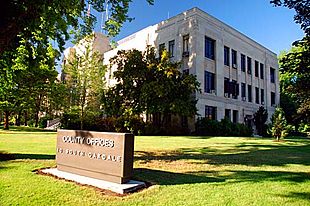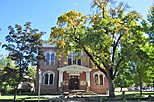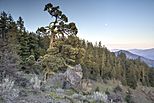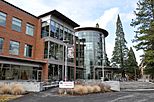Jackson County, Oregon facts for kids
Quick facts for kids
Jackson County
|
||
|---|---|---|
|
From clockwise: Jackson County Courthouse and Office Building, Medford Mormon Temple, Southern Oregon University's Hannon Library, Cascade–Siskiyou National Monument, Old Jackson County Courthouse
Jackson County Headquarters in Medford
|
||
|
||
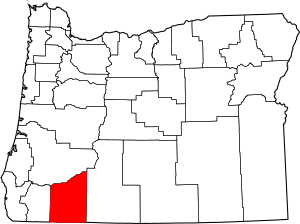
Location within the U.S. state of Oregon
|
||
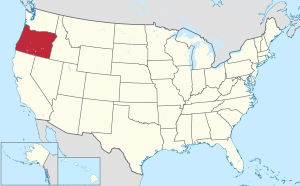 Oregon's location within the U.S. |
||
| Country | ||
| State | ||
| Founded | January 12, 1852 | |
| Named for | Andrew Jackson | |
| Seat | Medford | |
| Largest city | Medford | |
| Area | ||
| • Total | 2,802 sq mi (7,260 km2) | |
| • Land | 2,784 sq mi (7,210 km2) | |
| • Water | 18 sq mi (50 km2) 1%% | |
| Population
(2020)
|
||
| • Total | 223,259 | |
| • Estimate
(2021)
|
223,734 |
|
| • Density | 80/sq mi (30/km2) | |
| Time zone | UTC−8 (Pacific) | |
| • Summer (DST) | UTC−7 (PDT) | |
| Congressional district | 2nd | |
Jackson County is one of the 36 counties in the U.S. state of Oregon. As of the 2020 census, the population was 223,259. The county seat is Medford. The county is named for Andrew Jackson, the seventh president of the United States.
Jackson County comprises the Medford, OR Metropolitan Statistical Area.
There are 11 incorporated cities and 34 unincorporated communities in Jackson County; the largest is Medford, which has been the county seat since 1927.
Contents
History
Modoc, Shasta, Takelma, Latgawa, and Umpqua Indian tribes are all native to the region of present Jackson County. In the early 1850s, both the Klickitats from the north and the Deschutes from the south raided and settled the area.
The Territorial Legislature created Jackson County on January 12, 1852, from the southwestern portion of Lane County and the unorganized area south of Douglas and Umpqua Counties. It included lands which now lie in Coos, Curry, Josephine, Klamath and Lake Counties. Gold discoveries in the Illinois River valley and the Rogue River valley near Jacksonville in 1852, and the completion of a wagon road connecting the county with California to the south and Douglas County to the north led to an influx of non-native settlers.
Conflict between the miners and Native Americans led to war in 1853, which continued intermittently until the final defeat of the last band under chiefs John and George by a combined force of regular army and civilians May 29, 1856 at Big Bend on the Illinois River. The Native Americans had received the worse of the fighting throughout this conflict, and as they began to surrender, they were herded to existing reservations, beginning in January 1856 when one group was marched to the Grand Ronde Indian Reservation west of Salem. Over the following months, other groups were forced to leave until by May 1857 almost all of the Shasta, Takelma, and Latgawas tribes had been relocated to the Siletz Reservation, where they remained.
Jacksonville was designated as the first county seat in 1853. However, Jacksonville declined due to diminishing returns in the local goldfields and the construction in the 1880s of the Oregon and California Railroad. This railroad bypassed Jacksonville and instead went through Medford, located five miles (8 km) east of Jacksonville. Medford's prospects improved because of the location of the railroad and the accompanying commerce and development as Jacksonville continued its steady decline. Jacksonville fended off suggestions to move the county seat until 1927 when Medford was finally selected as the county seat.
In March 2004, Jackson County became the first of an eventual 35 counties in Oregon to implement a voluntary plan of fireproofing homes situated on properties zoned as part of the forestland-urban interface. This requires homeowners to maintain a 30' or greater firebreak around their structures, and affects 12,000 homeowners. In 2007 this plan becomes mandatory for many landowners, under threat of liability if their property is involved in a fire.
On May 15, 2007, residents voted not to reopen the county's 15 libraries, which had been closed since April 6 due to a shortage of funds. This was the largest library closure in the history of the United States. The libraries were reopened, with reduced hours, on October 24, 2007.
Geography

According to the U.S. Census Bureau, the county has a total area of 2,802 square miles (7,260 km2), of which 2,784 square miles (7,210 km2) is land and 18 square miles (47 km2) (0.6%) is water. A portion of the Umpqua National Forest is in Jackson County.
Located entirely within Jackson County is Bear Creek and its watershed, a tributary of the Rogue River. The population centers of Medford, Ashland, Phoenix, Talent, and Central Point are located along the stream. It connects with the Rogue River near the Upper and Lower Table Rock lava formations.
Adjacent counties
- Josephine County (west)
- Klamath County (east)
- Douglas County (north)
- Siskiyou County, California (south)
National protected areas
- Cascade–Siskiyou National Monument
- Crater Lake National Park (part)
- Klamath National Forest (part)
- Rogue River-Siskiyou National Forest (part)
- Umpqua National Forest (part)
Demographics
| Historical population | |||
|---|---|---|---|
| Census | Pop. | %± | |
| 1860 | 3,736 | — | |
| 1870 | 4,778 | 27.9% | |
| 1880 | 8,154 | 70.7% | |
| 1890 | 11,455 | 40.5% | |
| 1900 | 13,698 | 19.6% | |
| 1910 | 25,756 | 88.0% | |
| 1920 | 20,405 | −20.8% | |
| 1930 | 32,918 | 61.3% | |
| 1940 | 36,213 | 10.0% | |
| 1950 | 58,510 | 61.6% | |
| 1960 | 73,962 | 26.4% | |
| 1970 | 94,533 | 27.8% | |
| 1980 | 132,456 | 40.1% | |
| 1990 | 146,389 | 10.5% | |
| 2000 | 181,269 | 23.8% | |
| 2010 | 203,206 | 12.1% | |
| 2020 | 223,259 | 9.9% | |
| 2021 (est.) | 223,734 | 10.1% | |
| U.S. Decennial Census 1790-1960 1900-1990 1990-2000 2010-2020 |
|||
2010 census
As of the 2010 census, there were 203,206 people, 83,076 households, and 53,460 families living in the county. The population density was 73.0 inhabitants per square mile (28.2/km2). There were 90,937 housing units at an average density of 32.7 per square mile (12.6/km2). The racial makeup of the county was 88.7% white, 1.2% Asian, 1.2% American Indian, 0.7% black or African American, 0.3% Pacific islander, 4.5% from other races, and 3.5% from two or more races. Those of Hispanic or Latino origin made up 10.7% of the population. In terms of ancestry, 19.9% were German, 14.4% were English, 14.1% were Irish, and 5.3% were American.
Of the 83,076 households, 28.7% had children under the age of 18 living with them, 48.4% were married couples living together, 11.0% had a female householder with no husband present, 35.6% were non-families, and 27.7% of all households were made up of individuals. The average household size was 2.40 and the average family size was 2.91. The median age was 42.1 years.
The median income for a household in the county was $44,142 and the median income for a family was $53,739. Males had a median income of $40,435 versus $30,632 for females. The per capita income for the county was $24,410. About 9.9% of families and 14.0% of the population were below the poverty line, including 19.0% of those under age 18 and 7.4% of those age 65 or over.
Points of interest
Bear Creek Greenway
The Bear Creek Greenway is the area on both side of Bear Creek running from Ashland to Central Point. The Greenway's most popular feature is the bike path which runs from Ashland north towards Medford. Eventually it will be a 21-mile (34 km) paved link between Ashland and Central Point. The bike path is very popular with cyclists and skaters, especially during the warmer spring and summer months.
Oregon Vortex
Jackson County is home to the Oregon Vortex, a roadside attraction located in Gold Hill. It is an example of a gravity hill; the attraction contains several demonstrations of what are claimed to be phenomenons relating to the surrounding area, but skeptics would argue to be optical illusions.
Communities
Cities
Census-designated places
Unincorporated communities
Former communities
Economy
The county's principal industries are healthcare, agriculture, lumber, manufacturing, and tourism.
Jackson County has over 10,000 acres (40 km2) of orchards and shares with Josephine County the Rogue Valley and Applegate wine appellations.
Soapstone, a substance used in art sculpture, is mined in Jackson County.
According to the Jackson County Board of Commissioners, by 2021 the main cash crop produced within the county was the growing of illegal hemp, with the board declaring a state of emergency.
See also
 In Spanish: Condado de Jackson (Oregón) para niños
In Spanish: Condado de Jackson (Oregón) para niños


